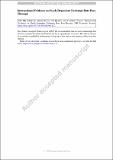International Evidence on Shock-Dependent Exchange Rate Pass-Through
Author(s)
Forbes, Kristin; Hjortsoe, Ida; Nenova, Tsvetelina
Download41308_2020_124_ReferencePDF.pdf (1.500Mb)
Open Access Policy
Open Access Policy
Creative Commons Attribution-Noncommercial-Share Alike
Terms of use
Metadata
Show full item recordAbstract
Abstract
We analyse the economic conditions (the “shocks”) behind currency movements and show how that analysis can help address a range of questions, focussing on exchange rate pass-through to prices. We build on a methodology previously developed for the UK and adapt this framework so that it can be applied to a diverse sample of countries using widely available data. The paper provides three examples of how this enriched methodology can be used to provide insights into pass-through and other questions. First, it shows that exchange rate movements caused by monetary policy shocks consistently correspond to significantly higher pass-through than those caused by demand shocks in a cross-section of countries, confirming earlier results for the UK. Second, it shows that the underlying shocks (especially monetary policy shocks) are particularly important for understanding the time-series dimension of pass-through, while the standard structural variables highlighted in the previous literature are most important for the cross-section dimension. Finally, the paper explores how the methodology can be used to shed light on the effects of monetary policy and the debate on “currency wars”: it shows that the role of monetary policy shocks in driving the exchange rate has increased moderately since the global financial crisis in advanced economies.
Date issued
2020-11-06Department
Sloan School of ManagementPublisher
Palgrave Macmillan UK